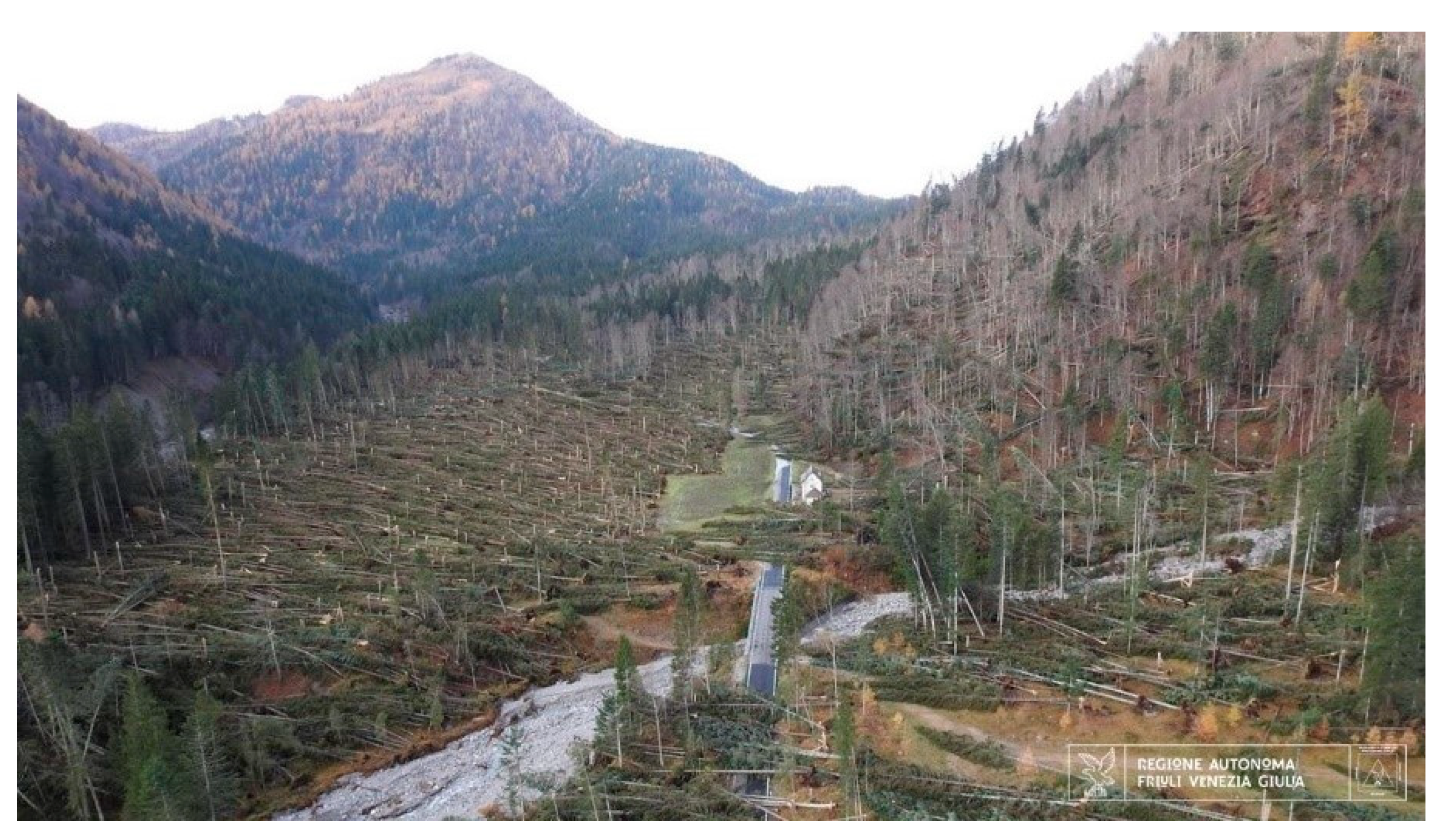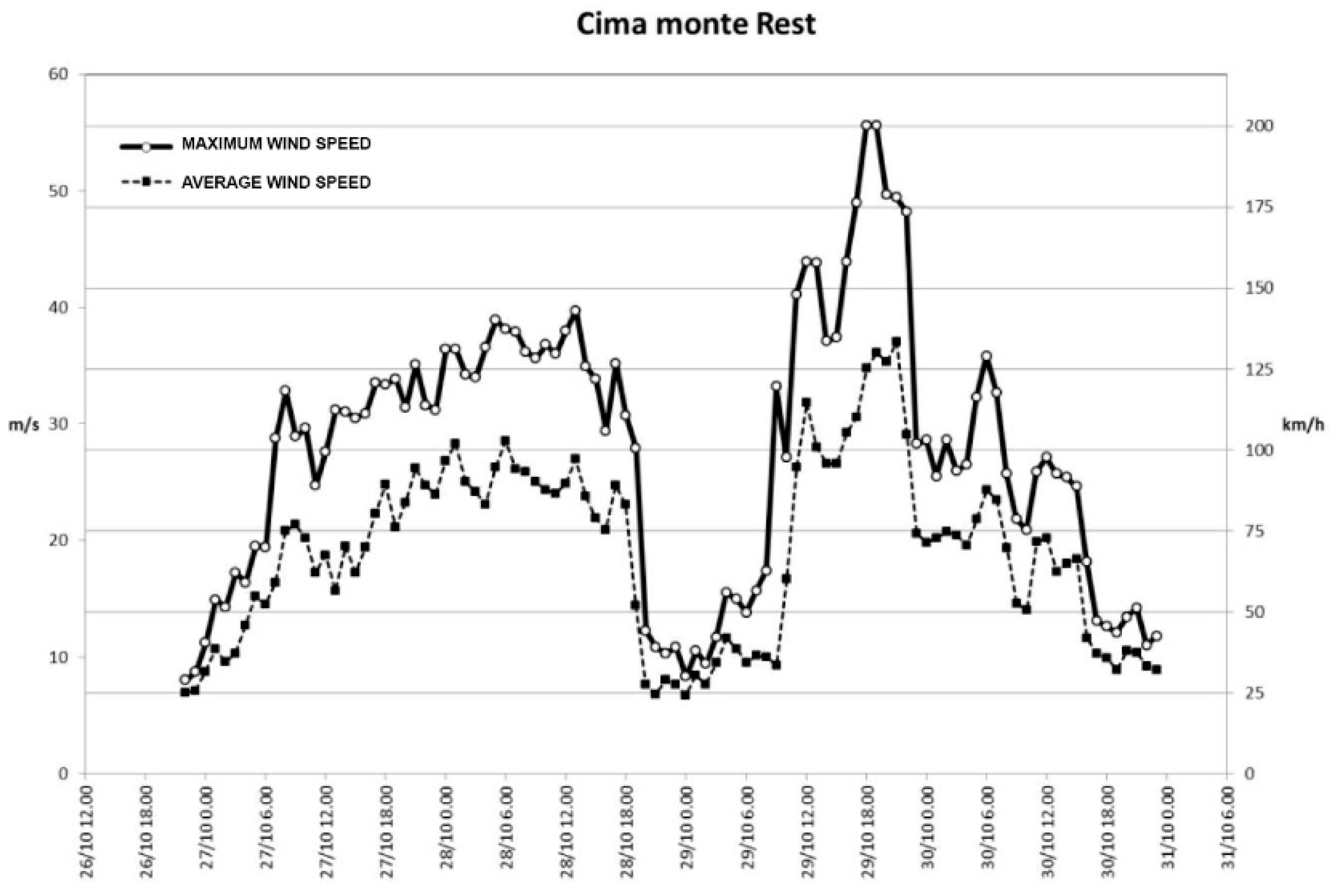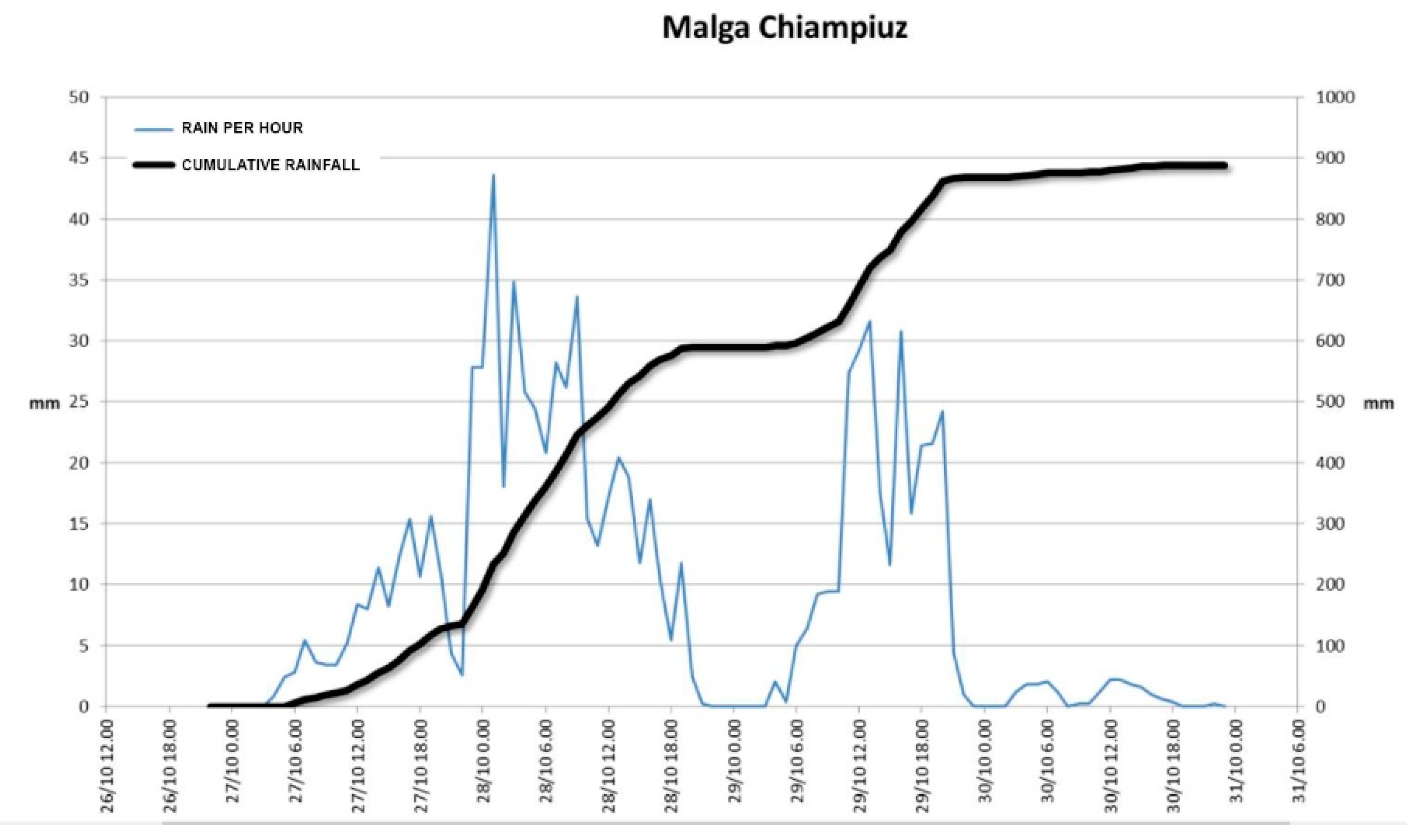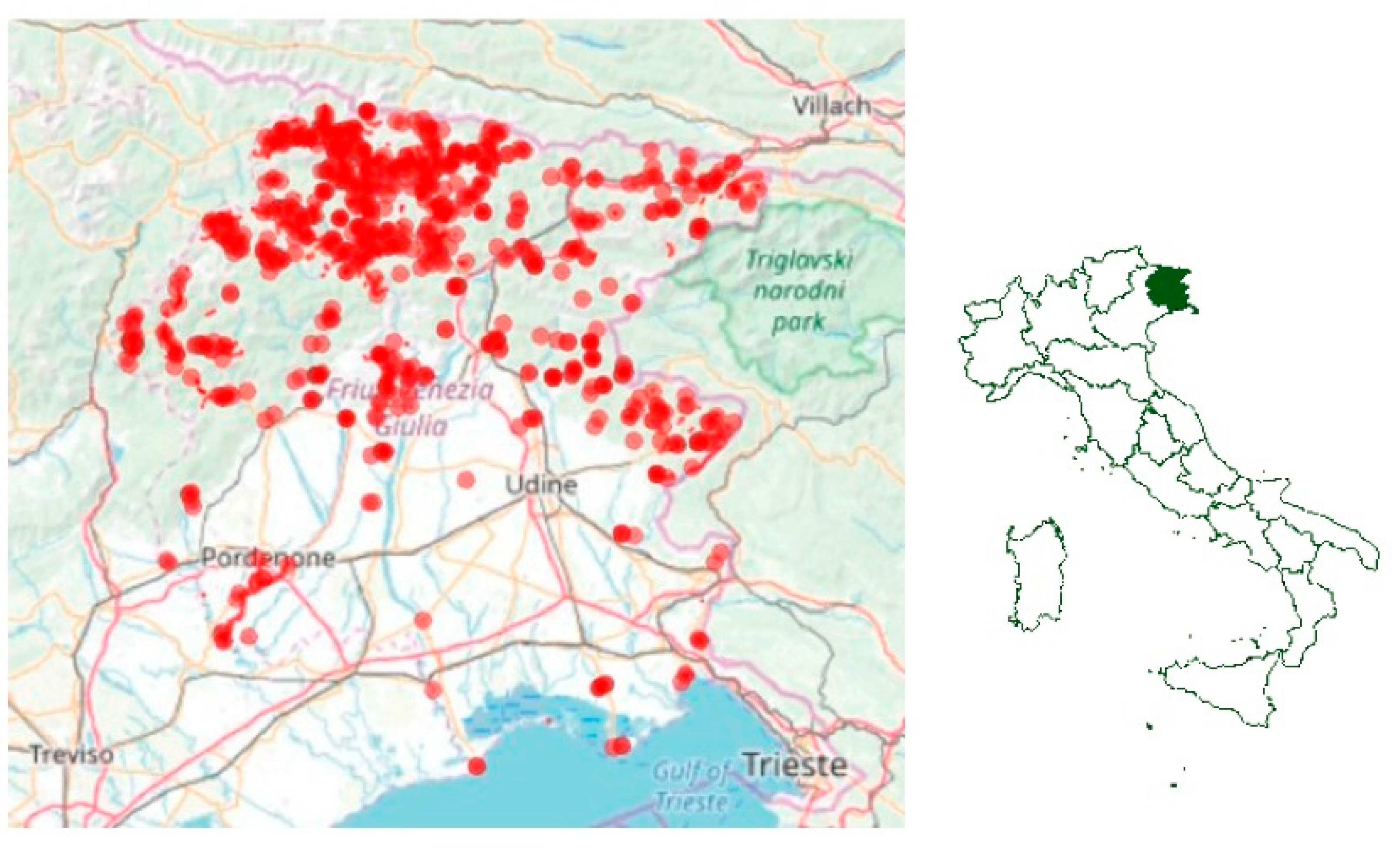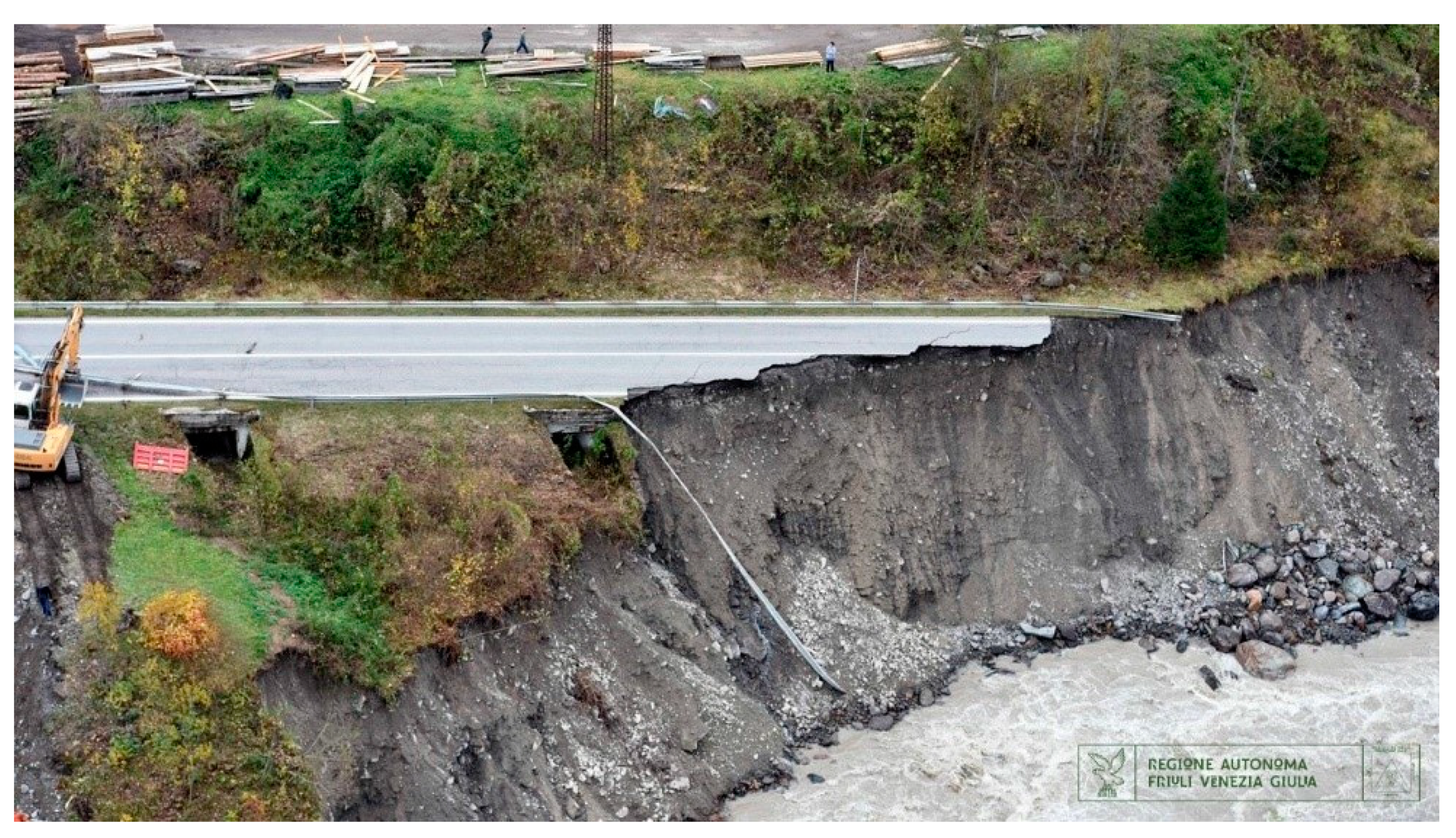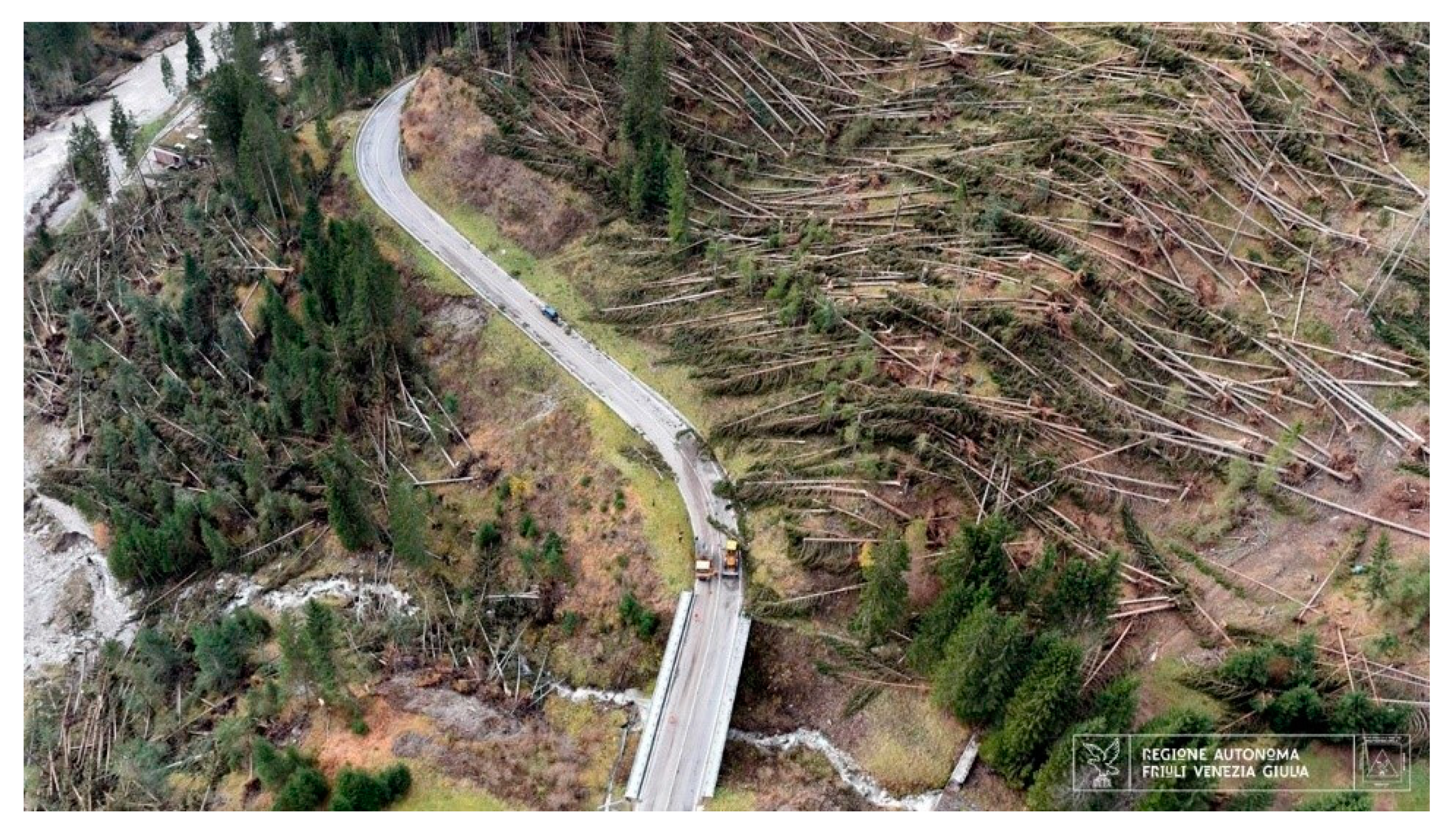1. Introduction
Adverse natural phenomena have afflicted our territories with increasing frequency and intensity in recent decades due to climate change. Although efforts to establish synergies and share good practices to prevent irreversible damage are significant tools, an increasingly holistic approach has proven necessary to ensure the achievement of more organic and decisive results in supporting even the smallest local authorities dealing with complex territories, accompanying them in the adoption of cutting-edge governance measures. Individual measures can no longer be virtuous exceptions: they must be catalysts for a significant improvement in development planning and programming. Actions in response to natural disasters can be used as an opportunity to re-educate people about a more conscious land use and to reintroduce more forward-looking, sustainable and responsible habits into the system.
The violent Storm Vaia hit northern Italy between late October and early November 2018, strongly affecting Friuli Venezia Giulia (
Figure 1). In order to respond to the Vaia emergency, the Italian Government invested in the region and appointed a delegated commissioner by order of the Head of the Civil Protection Department no. 558, on 15 November 2018. As envisaged in the order, the commissioner set up a new dedicated authority: the Commissioner’s Support Office 558, an internal structure of the region’s Civil Protection Department, with the task of managing the emergency funds allocated by the Italian Government and the European Union for restoration and increased resilience in the areas affected by the calamitous events. Through the office, the region coordinated all the phases of the post-emergency action: it offered technical–administrative support and specific skills, and centralized the definition of a complex financial and bureaucratic procedure, thus relieving the municipalities and strengthening the already existing synergies [
1].
The “Vaia Model” in Friuli Venezia Giulia follows the rules of the Civil Protection Code and Order 558 which define exceptions to rules to speed up the use of allocated resources. However, certain aspects make it a unique and virtuous case, such as the establishment of an office created as a temporary response to an exceptional case that has become a permanent tool to combine action in the immediate aftermath of the disaster with multi-year planning aimed at a comprehensive vision regarding increased safety in the fragile areas of the region. The region is using Office 558 to the optimize skills and resources of the local authorities, following a training–action–preparation scheme: (1) by raising awareness on issues of climate adaptation, land use and development planning; (2) by guiding municipalities in accessing national and European funds that allow them to carry out the measures necessary to make the territory safe, guaranteeing assistance throughout the technical, administrative and financial processes; and (3) approving measures that, when necessary, make changes to the urban planning instrument, immediately strengthening the regulation of the territory and offering new references of good practices to be taken as an example for the future. The envisaged dual action of damage response and increasing resilience through legislative instruments and project interventions, combined with the overall vision, are drivers towards a new way of planning by integrating long-term prevention systems. The office is committed to distributing the funds in a transparent manner, ensuring an inclusive and fair distribution among the affected areas. The objectives achieved are the result of intertwined administrative levels. The municipalities of Upper Friuli, negatively affected by the under-population of the inland areas, rely on a limited number of staff, subject to heavy workloads, and suffer from more difficult access to services. The “Vaia Project” responds to both these critical issues by offering support and services. However, this is an exchange on equal footing: local authorities of the mountain areas bring specific knowledge of the territory and they have great experience in the implementation of prevention and mitigation works of hydrogeological risk in adverse contexts.
In the three years since Storm Vaia, the office has effectively committed EUR 379 million of public funds, carrying out 1108 land safety and resilience enhancements and enabling small mountain and inland communities to make the most of the resources made available. Some of the most significant projects include the reconstruction, in one year, of a bridge that had completely collapsed and was of strategic importance in connecting two valleys; the reclamation of a lake identified as necessary during a cleaning operation following the storm (
Figure 2); the positioning of a prefabricated foot, lowered from a helicopter at high altitude to restore the continuity of a pedestrian route; and the restoration of cultural assets in an archaeological area invaded by flooding during Storm Vaia, to ensure its conservation and return it to the public.
The mission of Commissioner’s Office 558 is to define a plan for the distribution of funds that meet, in a targeted manner, the specific needs of each territory for the remediation of damage caused by Vaia and to increase the resilience to exceptional weather events. This action is also aimed at consolidating awareness of the importance of implementing risk reduction measures in planning tools. These interventions are collected in a cloud platform: an official working tool where the RUPs (project managers) are called upon to make available the documentary dossier detailing, step-by-step, all the stages of the project process, from mapping to completion. This transparency enables comprehensive and effective monitoring and leaves room for investigation and analysis when necessary.
Created to cope with an absolutely extraordinary condition and supported by tangible high-quality results, bringing solutions to critical issues that could not be tackled before, this system has become a governance model to be applied to fragile areas of the territory. The establishment of Office 558, in support of the extraordinary commissioner of the local authorities responding to impending criticalities, is an opportunity to integrate climate change adaptation measures into spatial development and land use planning in adverse contexts.
2. Vaia: The Natural Disaster
At the end of October 2018, a pronounced North Atlantic pocket reached the Mediterranean. This atmospheric phenomenon rapidly increased in intensity, reaching exceptional characteristics with wind gusts of 100 to 200 km/h over a vast area of northern Italy, Switzerland, Austria and Slovenia, causing devastation and destroying thousands of hectares of Alpine forests. Although the power of the winds classifies it as a hurricane, this violent atmospheric event characterized by a strong Sirocco, heavy rainfall and exceptional storm surges is known by the two names of Storm Vaia and Storm Adrian. On 27 October, the rainfall, initially moderate, fell on the Julian Pre-Alps with accumulations that locally exceeded 100 mm, progressively increasing in the following days and reaching 300 mm, up to 900 mm between the Carnic Pre-Alps and Carnia (
Figure 3). Similarly, the wind speed increased within twenty-four hours from 100 km/h to 180 km/h, reaching peaks of 200 km/h on Monte Rest, Malga Chiampiuz, at 1781 m above sea level (
Figure 4) [
3].
The heavy rainfall had an impact on the flow of the water bodies, causing massive rises in river levels along their entire course which exceeded warning levels and reached exceptional flood peaks. The measured water levels, bank erosion, subsidence and solid transport confirm that this was a historic event. It did not only affect the Alps and the Pre-Alps, but all hilly and lowland areas that suffered damage from floods and inundations. The strong Sirocco and changes in atmospheric pressure intensified the strength of the natural phenomenon and influenced the tides, resulting in storm surges whose waves reached a height of 4 m. A tide of more than 1.2 m lasted for over six hours. The water invaded the island of Grado and storm surges swept over the entire exposed coastline from Monfalcone to Lignano.
Vaia’s undeniable severity was immediately recognized, leading the authorities to a prompt activation of the emergency response system.
3. An Integrated Response: Action at the Local Level and the National Plan
In order to deal with emergencies triggered by exceptional natural phenomena similar to Vaia, the Civil Protection Department established a plan of procedures for the alert, emergency and post-emergency phases. Action at the local level is guaranteed by teams of volunteers and specialized technicians who are called upon to implement the most effective damage control solutions to protect citizens in a very short time. In October 2018, the action on the ground saw the involvement of: 1137 volunteers in the mountain areas of Carnia and Pordenone, engaged in cutting down trees, restoring roads and emptying flooded houses; 1169 volunteers for monitoring the territory; 92 volunteers for the flood service, monitoring basins and watercourses; 30 operators to guarantee 24 h radio connection; and 11 officials for coordinating the transport of materials and vehicles as well as communication. The alert lasted 10 days and involved 181 municipal civil protection groups, 14 associations, and more than 700 vehicles and instruments. In view of the seriousness of the forecasts, the Civil Protection Department’s emergency response specialists had already taken action in the pre-alert phase and begun to prepare the first preventive measures. In the operational phase of the alert, these were progressively implemented for a total of seventy emergency interventions to ensure safety. These grew in number as the events unfolded and the critical situation grew rapidly, collecting reports from the municipalities. The Autonomous Region of Friuli Venezia Giulia increased the amount of EUR 530,000 initially allocated [
4], with an additional EUR 4 million, guaranteeing interventions in 27 municipal areas (
Figure 5) [
5].
All Italian regions affected by the natural disaster were asked to submit an economic estimate of the damage they had suffered. These reports formed the basis for the definition of a national plan. Thus, while at the local level the interventions provided immediate solutions to the most critical situations, at the national level an emergency management system was defined that was capable of responding to specific needs, offering solidity, and at the same time flexibility to adapt to the very different contexts affected by the disaster. The Italian government declared a State of Emergency on 8 November 2018 [
7]. With Order no. 558, issued by the Council of Ministers on 15 November 2018, the President of the region was appointed Delegated Commissioner for the management of the emergency in Friuli Venezia Giulia, invested with special powers to issue the necessary measures for the safety of the affected areas and to increase the resilience to events with similar characteristics to Vaia in the shortest possible time [
8]. The following 20 December, the commissioner sent a survey of the damage with a request to the state of about EUR 560 million for 1138 interventions on public property and 356 on private property, such as family homes and the headquarters of local businesses and production activities (
Figure 6). It was immediately clear that such a large number of works, distributed over a large part of the regional surface, required the involvement of all the administrations of the territory: the municipalities, the central directorates of the region, the chambers of commerce, the land reclamation consortia, the in-house companies of the region for the management and maintenance of regional roads and, more generally, all the subjects that manage strategic structures and infrastructure. Only by distributing the implementation of the works would it have been possible to proceed simultaneously and quickly, ensuring the rapid securing of the territory.
For the management of civil protection emergencies, one of the instruments adopted by the state is to allow the Commissioner Delegate to open a special account at the Bank of Italy. This instrument allows funds to be made available and spent immediately and guarantees the transparency of financial transactions, which are carried out exclusively by means of Ministry of Economy and Finance software, called Geocos, which monitors payments and tracks flows in detail. It is a solution that allows the state to monitor the use of resources in a timely manner and the Delegated Commissioner to quickly direct payments without getting involved in the complex mechanisms of local public authority budgets. This system made it possible to overcome public finance constraints that would have led to longer periods of time being needed to commit resources, initiate procedures for awarding contracts, and make payments.
In the case of Vaia, the activation of the special accounting and the opening of a dedicated account at the Bank of Italy, the contents of which could not by law be allocated to other expenditures that did not have a causal link with the emergency, meant that the work of the Support Office never stopped and, consequently, that payments continued to be issued even during the crisis caused by the pandemic in recent years, to the benefit of local small businesses and professionals.
The resources allocated to the Autonomous Region of Friuli Venezia Giulia by the state were programmed over three years. Every year, from 2019 to 2021, by 31 January, the National Department of Civil Protection was sent a Plan of Interventions that, by 31 December of the same year of programming, would be entrusted to companies to carry out the works. To date, 1108 interventions on public property have been programmed for a total amount of EUR 380 million, and about 10 million contributions have been granted to families and local businesses. Although the resources were mainly coming from the state, it is important to underline that the severity of the event also led the European Union Solidarity Fund to grant about EUR 277 million to Italy, of which the Autonomous Region of Friuli Venezia Giulia benefited about EUR 26 million [
9].
The approach to the emergency followed a national strategy, but was built on the key principle of leaving organizational and management autonomy to the regions, which hold the specific knowledge of the territory, the needs, the criticalities, and the dynamics present at the local scale. The President of the Autonomous Region of Friuli Venezia Giulia, in his role as Delegated Commissioner, through the Support Office, chose to apply a system based on the centralization of administrative management, technical supervision, and the monitoring of plans, combined with the autonomy of the local authorities regarding reconnaissance, choice of technologies, and the development of the project, applying their valuable knowledge.
4. The Office in Support of the Commissioner 558 of the Autonomous Region of Friuli Venezia Giulia: The Organization of a Post-Emergency Action Plan
The Autonomous Region of Friuli Venezia Giulia built a management model for achieving the set objectives within the strict and imperative deadlines, defining both a logistical and administrative system.
At the heart of the logistical apparatus was the Commissioner’s Support Office 558, headed by the Delegated Commissioner, a structure set up in the days immediately following the disaster, which initially counted only six people and complemented the field work of the Regional Civil Protection Department. The office staff were strengthened over time to adequately cope with the great workload expected, reaching 25 officials and collaborators involved in coordinating the post-emergency phase. The mission that the Office was entrusted with was to supervise all aspects of the implementation process of the interventions, and to coordinate the work of all the territorial management entities that contributed to the definition of hydrogeological risk reduction mechanisms and planning tools for the use of land, including: municipalities, regional departments, chambers of commerce, consortia, in-house companies of the region and, in general, all subjects managing strategic structures and infrastructure. The involvement of these stakeholders was based on the need to join forces, and founded a catalyst in the burning desire of all parties to contribute to the reconstruction of the lands devastated by the natural disaster. By distributing the implementation of the measures, it was possible to proceed quickly to repair the huge damage in a coordinated and effective manner, using the available funds to carry out as many works as possible to quickly secure the critical areas while ensuring a high level of technical execution (
Figure 7).
At the heart of the administrative apparatus of the Vaia Model was a structural organization based on the distinction of the actors involved in “Implementing Parties” and “Auxiliary Parties”. The former denomination gathered public asset managers who did not have budgetary constraints, and thus had greater accounting flexibility and internal tools to manage large projects independently, relying on the Support Office almost exclusively for access to funds and the reimbursement of expenses incurred. The latter grouped together local authorities such as municipalities, inter-municipal territorial unions and mountain communities that had budgetary constraints. They were given the task of surveying, planning, and carrying out interventions, while keeping both the approval of projects and the payment of expenses centralized. The “Auxiliary Parties” were all answerable to a single “Implementing Subject”: the Commissioner’s Delegate 558, Vice-President and Deputy Minister for the Civil Protection of the Autonomous Region of Friuli Venezia Giulia, who acted through the Support Office and the Civil Protection Department. The key to the success of the system was in relieving local authorities, especially small municipalities, from dealing with complex accounting systems, by giving them direct access to resources and allowing them to concentrate on the design and implementation phases of the works, knowing that they could count on a solid supporting structure.
For both subjects, the Support Office defined the procedures for carrying out the interventions and the relations between the parties involved, provided a uniform interpretation of the exceptions to the regulations that the state of emergency made possible to apply, and offered a space for exchanges and meetings, both physically and through a network, allowing all the subjects involved to cooperate in achieving the shared objective. Programming is defined each year by the office, which monitors compliance with the dictated guidelines, the timetable, the fiscal procedures, and the quality of the whole process in accordance with the law and following the collection of the necessary authorizations.
One of the main difficulties at the start was coordinating such a heterogeneous variety of contributions: it was decided to create an online archiving platform that would be a real shared working tool, called the “Commissioner’s Portal”. Its structure was designed in 2018 and improved over the years based on the feedback received year by year, becoming increasingly complete and user-friendly, until it became not only a cloud but a platform for exchange and interaction that guaranteed authorized parties access to all project documents, authorization acts, and accounting documents. However, the use of an online management system was not customary for all users: the actors involved came from very different backgrounds and not all were equally familiar with the digitization of procedures. The Support Office was, therefore, also committed to enhancing digital literacy, offering help in using these tools, in person and remotely, aware that this growth would be useful not only for the achievement of the objectives of the three-year post-emergency Vaia programming period but for the efficiency of the same small local administrations that would benefit from it in all their territorial government activities.
Through the sharing of information, coordinated by the Support Office and filed in the Commissioner’s Portal, and organized with actors and constant monitoring, it was possible to allocate funds and complete the planned projects, especially in the most marginal and complex areas. By coordinating the actions of the stakeholders involved in securing the territory from the damage caused by Vaia and increasing its resilience, the Support Office ensured the application of the correct risk prevention measures by offering a model applicable throughout the region. The multi-annual program defined by the Commissioner looks at a broader framework of transformation, where each individual intervention contributes to strengthening the territorial response to natural disasters.
5. Conclusions
Launched to manage exceptional scenarios and backed by the quality of its tangible results, this proven system has become a model of governance for all fragile areas in the region. The aim of the Commissioner’s Support Office 558 was to bridge the gap between national planning and local administration, encouraging the adoption of cutting-edge governance measures even in the most remote territories. This system has become a management model for promoting innovation and spreading the integration of climate change adaptation measures: the centralized management of the system ensures speed of action and supports local expertise by enabling them to carry out significant engineering work. The effectiveness of this strategy lies in understanding what the strengths of each party are and what burdens can be lifted from the actors involved in order to streamline the whole procedure and achieve as many objectives as possible in the shortest possible time, while preserving the quality of the work. The synergy between the region and the local authorities is reinforced, and the mutual support agreement confirms the solidity of an even more successful partnership.
The spread of digitalization continues: the Civil Protection Department of the Autonomous Region of Friuli Venezia Giulia has embraced the new networking tools put in place in the post-emergency phase and is integrating them into its emergency response system, so as to ensure continuity in communication and monitoring at every stage. At the same time, the Regional Civil Protection Department continues to invest resources in the development of digital prevention and warning tools for exceptional atmospheric events, which produce both outputs dedicated to specialized technicians and outputs available to citizens, presented through a simple and intuitive interface. Easily accessible from the website, and from a dedicated app soon to be developed, a dynamic map, updated in real time, shows the forecasts processed by the regional radar for the following hours, precisely delimiting the areas exposed to greater danger, subject to exceptional natural phenomena such as the Vaia Storm. This tool is designed to spread the alarm quickly, alerting each user immediately, and to offer a very precise and early picture of what the most at-risk area will be in order to find shelter [
10].
The Vaia case study shows the importance of a holistic and synergistic approach, demonstrating that the use of innovative technologies is not limited to privileged territories at the center of large service networks; on the contrary, this management model can be applied to spread the adoption of climate change adaptation measures. The formative value of this system includes a commitment to the dissemination of digitalization and the integration of new planning standards for hydro-geological risk mitigation. Their inclusion in spatial planning instruments at the local scale ensures significant increases in the resilience of critical areas in responding to severe weather events.
The Commissioner’s Support Office 558 plays a central role in the control of a capillary system capable of providing the overall image designed for a profound transformation oriented towards securing the territory, and is a replicable model. Cases such as this must be catalysts for significant change in land use and development planning, introducing new objectives that aim at moving towards a system of governance that is increasingly sensitive to climate change.
